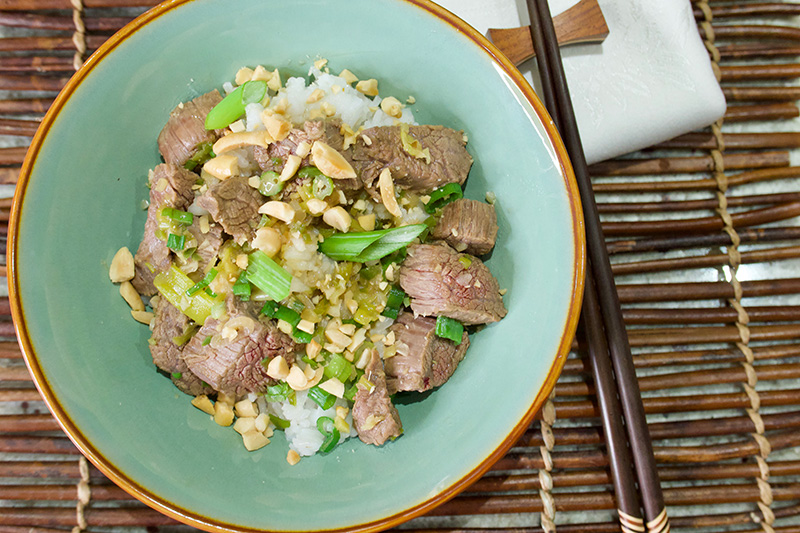Special Diet Information
Coumadin® (Warfarin)
This recipe is NOT safe for Coumadin (warfarin) users.
Lactose
This recipe is safe for those who are lactose intolerant.
Sodium
This is a low sodium recipe.
GERD / Acid Reflux
This recipe contains GERD triggers and those with GERD may wish to avoid it.
Gluten Sensitivity
This recipe is safe for those who are sensitive to gluten. Use low sodium gluten-free tamari sauce in place of the low sodium soy sauce.
"When it comes to Chinese food I have always operated under the policy that the less known about the preparation the better. A wise diner who is invited to visit the kitchen replies by saying, as politely as possible, that he has a pressing engagement elsewhere." -Calvin Trillin, Writer
The refrigerator light goes on...
I like spicy food but not too spicy. This is literally the one pepper version and is pretty mild so it's easy to make this spicier by adding peppers to your desired level of heat.
One way to control how much spiciness is in dishes like this one is to use chili oil. This is widely available now, and very common in Asian markets, but your grocery probably carries it.
Simply replace some of the oil that you use to stir fry with the chili oil. Start slowly at first - a half teaspoon for two servings may be enough for you (it is for me). Each time you cook, use a little more if you want more heat. It's a great ingredient to have around: it adds the flavor of a spicy chili pepper, but you don't have to take the time to seed and mince.
Kung Pao Beef
Servings: 4 | Serving size: 4 ounces beef with vegetables and rice
Cooking Time: 30 Minutes
This recipe can easily be multiplied and makes great leftovers.

Ingredients
- 16 ounces flank steak (cut into 1 inch cubes)
- 2 tsp low-sodium soy sauce or gluten-free tamari sauce
- 2 tsp sake or sweet white wine
- 1 tsp sesame oil
- 2 tsp rice vinegar
- 2 tsp honey
- 1 tsp cornstarch
- 2 cups water
- 1 cup jasmine rice
- 1 Tbsp sesame oil
- 2 cloves garlic (minced)
- 1 inch ginger root (peeled and minced)
- 1 small red chili pepper (seeded and minced)
- 4 green onions (cut fine crosswise)
- 2 Tbsp rice vinegar
- 2 Tbsp low-sodium soy sauce or gluten-free tamari sauce
- 3/4 cup water
- 1/4 cup dry roasted peanuts (chopped coarsely)
Place the 2 teaspoons low-sodium soy sauce, sake, 1 teaspoon sesame oil, rice vinegar, honey, and cornstarch in a bowl and stir until well blended. Add the flank steak cubes and toss until coated. Place the bowl in the refrigerator.
While the beef is marinating place the water in a medium sauce pan over high heat. When the water boils, stir in the jasmine rice.
Reduce heat to medium-low and simmer, partially covered, for about 25 - 30 minutes.
Do not boil away all of the liquid and do not stir the rice.
When a very small amount of liquid remains, remove the pan from the burner and let it stand, covered, for 5 minutes before serving.
After cutting the green onions, separate the white and green part.
When the rice is done, place a large skillet or wok over high heat. Add the sesame oil and heat for a few moments. Reduce the heat to medium and add the ginger, garlic, chili pepper, and the white part of the green onions. Cook for about one minute.
Add the beef and cook for about one minute, tossing frequently until browned on all sides.
Add the rice vinegar and soy sauce. Continue cooking the beef, tossing frequently. When the beef is nearly done to your liking, fold in the green part of the green onion and the 3/4 cup water. Cook for another minute.
Serve over the rice and top with the peanuts.
Nutrition Facts
Serving size: 4 ounces beef with vegetables and rice
Servings: 4
Amount Per Serving
| Calories 490 | Calories from Fat 171 |
| % Daily Value |
| Total Fat 19g | 24% |
| Saturated Fat 5g | 27% |
| Monounsaturated Fat 8g | |
| Trans Fat 0g | |
| Cholesterol 75mg | 26% |
| Sodium 450mg | 20% |
| Total Carbohydrates 46g | 17% |
| Dietary Fiber 2g | 8% |
| Sugars 4g | |
| Protein 31g |
| Vitamin A 0% | Vitamin C 11% |
| Calcium 6% | Iron 25% |
| Vitamin K 50mcg | Potassium 600mg |
